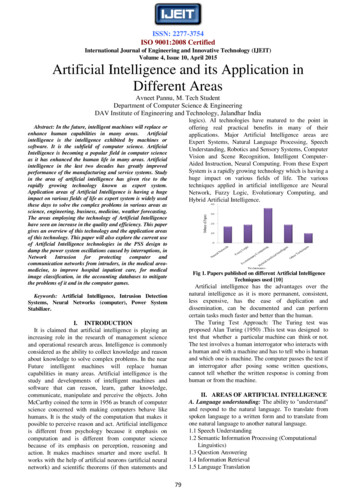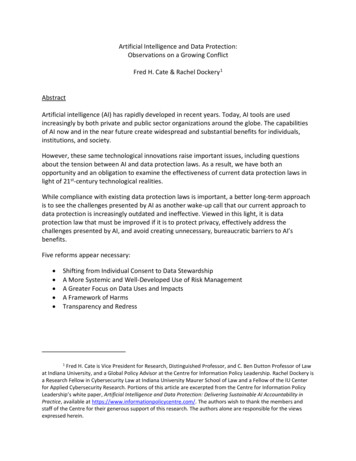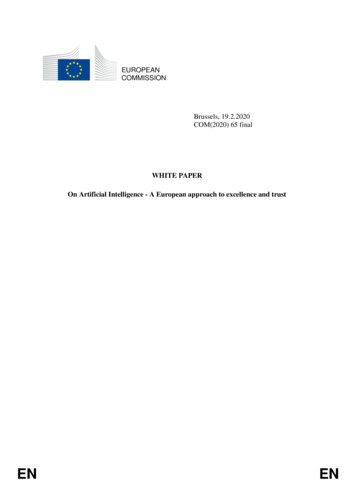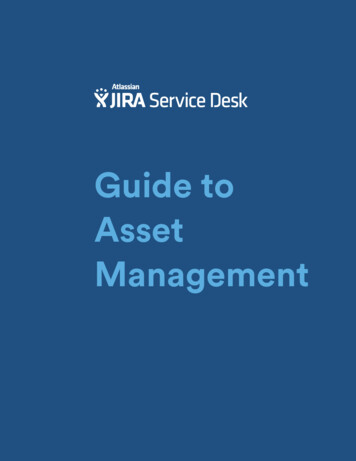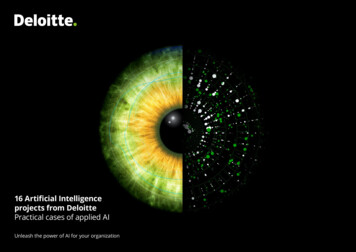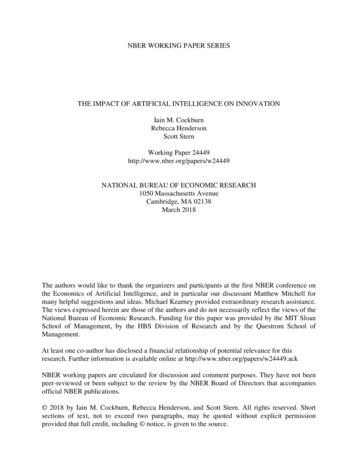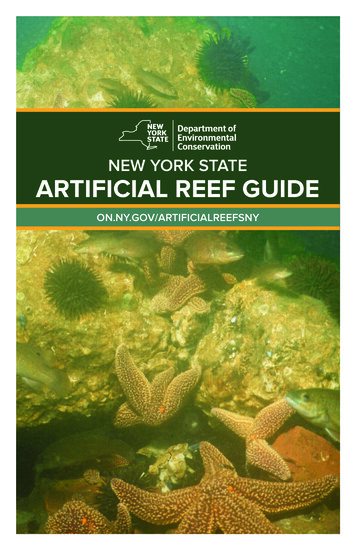
Transcription
NEW YORK STATEARTIFICIAL REEF GUIDEON.NY.GOV/ARTIFICIALREEFSNY
Artificial ReefsLong Island’s Sunken TreasureLong Island beaches are a nationaltreasure, world-renowned for their finewhite sand, spectacular waves, miles ofboardwalks, beach trails, restaurants,picnic areas, and beautiful sunrises andsunsets. Just miles offshore visitors canfind Long Island’s “Sunken Treasure,” 12artificial reefs developed by New YorkState to improve sport fishing and providenew and exciting diving destinations.Largest Expansion in State HistoryIn 2018, New York State commenced the largest expansion of artificial reefs inState history. Recycled material, including boats, barges, old Tappan Zee Bridgematerials, steel trusses, pipes, and girders, concrete panels, and much more havebeen deployed on existing reef sites to enhance the marine habitat.Recreation on the ReefsInvesting in our local marine habitat and enhancing artificial reef sites providesnew opportunities for all New Yorkers to enjoy our valuable and unique marineenvironment. The recycled structures that are deployed on artificial reefs provideadditional fishing and diving opportunities, and support businesses that employthousands of Long Islanders.
Division of Marine ResourcesArtificial Reef Guide123 Kings Park Blvd.,Kings Park, NY 11754artificialreefs@dec.ny.govShare Your ReefObservations with Us!Please feel free to share anyphotos you have of fishing ordiving on our reefs and let usknow if we have permissionto use them. Each year, wewill select one or two photosfor the cover of this guideor one of our artificial reefwebpages!Cover photo by Shaun SneeEmail your photos to:artificialreefs@dec.ny.gov
Report Environmental CrimesTo contact an Environmental Conservation Police Officer or report suspectedviolations, call the DEC Law Enforcement Dispatch Center at1-844-DEC-ECOs (1-844-332-3267)or use the online reporting system reational Marine Fishing RegistryWho Needs to RegisterYou need to register if you are 16 and older and are: Fishing for saltwater fish species in the marine and coastal district. Fishing for migratory fish of the sea (striped bass, American eel, hickory shad,American shad, anadromous river herring) within tidal waters of the HudsonRiver and its tributaries, or in waters of the Delaware River or Mohawk River.Get Your Sporting Licenses or Register for Marine Fishing Online: https://decals.dec.ny.gov/DECALSCitizenWeb By Phone: 1-866-933-2257 (Mon - Fri 8:30 AM - 7:00 PM and Sat 9:00 AM - 5:00 PM)Recreational SaltwaterFishing RegulationsBefore heading out, make sure tocheck the fishing regulations forupdates or changes. You can dothis by checking out our webpage athttps://www.dec.ny.gov/outdoor/7894.htmlor by downloading the NY Fishing,Hunting & Wildlife App here:Recreational Lobster PermitIf you are heading out to the reefs and arehoping to take home a lobster, you are requiredto have a Recreational Lobster Permit. This noncommercial permit allows a NYS resident to setno more than five lobster pots, and take or land no more than six legal lobsters inone day by this or any other legal method for the holder’s own or family use.How to Apply1 Visit https://www.dec.ny.gov/outdoor/100613.html to download an applicationor contact the Marine Permit Office at (631) 444-0470.
American lobsterin a steel pipe onHempstead ReefPhoto by Chris LaPortaArtificial Reefs in New YorkThe New York State Artificial Reef Program was officially created in 1962,although the documented construction of New York’s first artificial reef datesback to the 1920s in the Great South Bay. DEC established a Marine ArtificialReef Development and Management Plan in 1993.Currently, New York has 12 artificial reef sites, including: Two in Long Island Sound Two in Great South Bay Eight in the Atlantic Ocean on the south shore of Long IslandThe Reef Program uses the “patch reef” method of construction where cleanrock, concrete, and steel in various forms are placed on discrete parts of thereef site leaving natural bottom habitat in between. Placing different materialin “patches” on each site provides a variety of habitats for marine life and hasbeen documented to increase species diversity.Under the NYSDEC Reef Development and Management Plan, the ReefProgram has successfully enhanced New York’s artificial reef sites throughthe addition of hundreds of patch reefs. Patch reefs have been created usinga variety of materials that meet both national standards and New York ReefProgram guidelines.The Reef Program has worked cooperatively with federal agencies (U.S. ArmyCorps of Engineers, U.S. Coast Guard and National Marine Fisheries Service),local fishing clubs, and other groups to improve reef sites through reef materialdonation and project sponsorship.In 2018, the NYS Artificial Reef Program began the largest expansion in statehistory. This expansion includes the deployment of cleaned recycled materialsfrom the New York State Canal Corporation (NYSCC), New York State ThruwayAuthority, New York State Department of Transportation (DOT), the New YorkPower Authority (NYPA), and the U.S. Army Corps of Engineers.Tautog (blackfish)swim over pipes onRockaway Reef.Photo by Dan Mundy2
What is an artificial reef?Artificial reefs are manmade structures which are recycled to provideadditional habitat to fish and other aquatic organisms. They are made with avariety of hard, durable materials, which are selected based on their function,compatibility, durability, stability, and availability. These characteristics ensurethat, once deployed, the material will provide suitable habitat for marine lifethat is safe, effective, and long lasting.Artificial Reefs Create Marine HabitatArtificial reefs are used to create complex habitat in areas which lack intricatenatural hard bottom structure. This is common off the shores of New York whichprimarily have flat sand/silt bottoms. Artificial reefs enhance the environment bycreating a biologically diverse area which provides food and shelter to a rangeof marine organisms. Over time, hard structures on the reefs are covered withalgae, mussels, barnacles, sponges, anemones, hydroids, temperate corals,and other types of encrustingorganisms.Many fish and crustacean species,including black sea bass, tautog(blackfish), scup (porgy), summerflounder (fluke), and lobsters areattracted to reefs and the surroundingarea for food and shelter. Fish alsouse artificial reefs for spawning. Asan artificial reef matures, it resemblesa natural reef and provides increasedfishing and diving opportunitiesfor the public.3Charter fishing boat off Fire Island National Seashore
Artificial Reef Citizen ScienceDo you fish or dive New York’s artificial reefs?While visiting New York’s artificial reefs, you can observe a variety of uniquemarine habitats, organisms, and environmental conditions. Please considersharing your observations with the DEC Artificial Reef Program. The informationyou provide via our survey will help us learn more about the marine life on ourartificial reefs and how to improve your experience on our reefs. The surveycan be downloaded and completed from your phone orhome computer: https://www.dec.ny.gov/outdoor/9211.htmlUsing a smart phone or tablet, scan the QR codeto access the digital surveyMatthew Kessinger holding his New York State Record13.45lb Atlantic bonito caught off of Atlantic Beach Reefin November 2020.Matt Roth holding a 17.3lb blackfish(tautog) caught off Atlantic BeachReef in Fall 2020.4
Popular Sportfish of Artificial ReefsAtlantic CodAtlantic cod are a cold-water species found from Greenland to Cape Hatteras,North Carolina. They spawn in the winter and early spring and can live over 20years. Cod are sensitive to increasing ocean temperatures, which have beenlinked to declining cod populations. Cod are seasonal visitors to artificial reefs anduse reef structure for shelter and foraging.Tautog (Blackfish)*Blackfish reside along the Atlantic coast from Nova Scotia to Georgia. They areslow growing and can live up to 40 years. They migrate inshore during the springand move offshore as the water temperature drops through the fall. Blackfish usetheir strong jaws and teeth to chew up crabs, mussels, clams, and barnacles. Theyare commonly seen around natural and artificial structures. Blackfish are one ofthe most prized and sought-after species on our artificial reefs.Black Sea BassBlack sea bass can be found on the eastern seaboard from Maine to Florida. Inthe northeast, they migrate inshore in the summer and offshore in the winter. Asocean temperatures have warmed, black sea bass populations have expandednorthward. Black sea bass begin their lives as females and some become malesbetween 2 and 5 years old. Black sea bass can live up to 20 years. These fish liveamong rocks, wrecks, and other underwater structures and are highly sought afteron artificial reefs.5
BluefishBluefish inhabit temperate waters throughout much of the world. They arevoracious predators and are known for their sharp teeth, which they use to makequick work of their prey. They can live up to 12 years and migrate into New Yorkwaters in the spring and summer. Bluefish stop at artificial reefs to feed. Anglersseek them out for their fight and willingness to attack lures thrown their way.Scup (Porgy)Scup, or porgy, inhabit marine waters between Massachusetts and North Carolina.They are a schooling fish that can live up to 20 years. They migrate inshore duringthe spring and are found on artificial reefs feeding on worms, small crustaceans,and fish. They are a popular sportfish that provide a good fight for their size.Striped bassThe striped bass inhabits the Atlantic coast from Canada to Florida. They areanadromous, which means they migrate from saltwater into fresh water to spawn.They migrate north in the spring, and back south in the fall, where they overwinteroffshore. Striped bass can live up to 30 years and frequent NYS’ artificial reefssearching for a meal.Summer Flounder (Fluke)*Summer flounder (fluke) occur along the coast from Nova Scotia to Florida. Theyare bottom-dwelling fish that camouflage themselves in the bottom and ambushunsuspecting prey. Fluke migrate inshore in the spring and offshore in the winter.They begin their lives with eyes on both sides of their body. The right eye movesto the left side as they develop into juveniles. They can live up to 14 years and canbe found on the bottom in and around artificial reefs.6
Common Species of Artificial ReefsAmerican LobsterThe American lobster is found along the east coast of the United States, primarilyfrom Maine to New Jersey. In order to grow, lobsters shed their shells (molt) asthey get bigger. Female lobsters carry eggs for up to 11 months, after which babylobsters hatch and are released into the water column. Lobsters are sensitive totemperature and tend to avoid areas with temperatures above 68 F. Look for themhiding in cracks and crevices of the artificial reef materials.Bergall (Cunner)Cunner live among pilings, jetties, and artificial reefs from Canada to theChesapeake Bay. People sometimes confuse them with blackfish, but cunnerare generally smaller, less stout, and have a more pointed snout. Anglers oftenconsider them a nuisance for stealing bait, but cunner can be eaten, and providefun for the kids when many other fish aren’t biting.Conger EelConger eel live from Massachusetts to the Gulf of Mexico in the United States.People often confuse them with the American eel; look for the conger’s longerdorsal fin and snout. Like the American eel, conger eel spawn once in theirlifetime. Adult eels of both species spawn in the Sargasso Sea, and larvae ride theocean currents along the coast, where they eventually settle and begin to grow.Gray TriggerfishRanging along the U.S.’ entire eastern coast, gray triggerfish show up in New Yorkwaters in the summer. They forage in artificial reefs for benthic invertebrates suchas crabs, shrimp, and mussels that they crush with their strong jaws and teeth.Triggerfish can live up to 16 years.7
Ocean Pout**Ocean pout inhabit marine waters from Canada to Delaware. They can reach upto 3 feet long and weigh up to 14 pounds. They range over a wide array of depthsand are thought to move seasonally between different substrates. They mainlyfeed on invertebrates like worms and crabs, but will also eat other fish when giventhe opportunity. They prefer rocky areas and artificial structures.Red Hake (Ling)Red hake are also known as ling and can be found from Canada to North Carolina.They prefer colder water temperatures—up to 54 F. They use artificial reefs forfeeding and hiding from predators. Red hake are related to the Atlantic cod andcan live up to 14 years.Rock CrabRock crabs reside along the east coast of the United States from Canada toSouth Carolina. They can be found in shallow waters to depths over 2,000 feet.Rock crabs are often confused with Jonah crabs but are generally smaller, have asmoother carapace (shell) edge, and purplish-brown spots.Sea RobinIn New York, the two common sea robins are the striped sea robin and thenorthern sea robin. Both species are generally found from southern New Englandto the Carolinas. Sea robins have bony heads with spines and use their wing-likepectoral fins to walk along the bottom and stir up prey. When caught, they oftenmake a croaking sound. Although not commonly kept for food, they area good eating fish.Photo credits:* ASMFC fish illustrations by Dawn Witherington** Drawing provided courtesy of the Maine Department of Marine Resources Recreational Fisheries programand the Maine Outdoor Heritage Fund8
Fishing: Popular Rigs for ReefsFishing Rig Illustrations courtesy of The Fisherman MagazineFishing: Catch and Release Best PracticesSport fishing can cause injury to fish through the acts of hooking, landing, andunhooking the catch. This is not a problem for fish that will be kept for eating,but injuries to fish that are released back into the water can result in death.9
Many anglers assume that if a fish swims away after release, it will survive,but this is not always the case. Most fish that do not survive after release diebecause an angler doesn’t understand how their actions and environmentalconditions combine to harm the fish.Catch-and-release can be broken into three phases: capture, handling, andrelease. The tips and practices below will help to ensure fish have the greatestchances for survival after release.Capture Fish using tackle appropriate to the size class of the fish you aretargeting. Never fight a fish to exhaustion as this can impair swimmingability post release. Use non-offset circle hooks when fishing with live or cut bait. Circle hooksusually hook a fish in the jaw and not in the gut or throat, making it easierand faster to release the fish. Avoid treble hooks, and crush or file off barbs on hooks to reducede-hooking time. If a fish becomes gut-hooked, cut the leader as closely as possible to thehook and leave the hook in place; it will rust out after a short time. Do not gaff a fish unless it is legal size and you intend to keep it. Consider the environmental conditions when hooking and fighting a fish.Warmer water holds less dissolved oxygen and increases the rate at which afish’s body uses oxygen, so anglers should avoid long fights in warm water.Handling Minimize the fish’s exposure to air, keeping it in the water at all times if possible. Warm air temperatures and/or direct sunlight will cause a fish’s gills and bodyto lose moisture rapidly. Handle fish with wet hands, and if using a landing net, use a “knotless” onethat does not remove slime or scales from the fish. Because fish live in a relatively weightless environment, holding a fishvertically shifts internal organs unnaturally and can dislocate bones in thefish’s spine. If you must handle a fish, hold it horizontally and firmly, andsupport its weight under the belly. Never hold a fish by its eyes or gills. Be prepared by having any necessary tools on hand before landing a fishto help reduce the time a fish may be out of the water during thede-hooking process.10
ReleaseAlways revive your catch before releasing it: While in control of the fish, orient it headfirst into the current, then gentlymove the fish in a side-to-side pattern so that water flows through the mouthand over the gills. Keep the fish moving forward; never move it backward as that canimpede the ability of the gills to extract oxygen from the water. Do not let the fish go until it is able to swim strongly out of your grasp.BarotraumaEver pull up a fish while bottom fishing and have it come up looking like the fishin the pictures below? Some fish have swim bladders which help them controltheir buoyancy. These air-filled sacs expand as the fish is reeled to the surfacedue to their inability to release gases as the pressure rapidly changes. Signsof fish with barotrauma injuries include bulging eyes or vent, bloated belly,and/or the stomach protruding from its mouth. The survival of a fish displayingbarotrauma is low as the fish is likely to float on the surface.Robert A. FisherVirginia Institute of Marine ScienceThe best way to improve the survival of a fish displaying barotrauma, is byreturning a fish down to the depth (and pressure) where it was caught. This willre-compress the gas in the fish’s body. You can build your own “fish descender”or purchase one (search online for “fish descending devices”). The undersizedfish you catch and release are the future of the fishery, so do your best to helpthem survive!11
Artificial Reef Etiquette Do not crowd boats that were on the site before you. Keep an eye out for diver-down flags and stay clear ofareas where people are diving. Observe all state and federal fishing regulations. Do not throw trash overboard. Fishing line, plastic, and other types ofgarbage can kill marine life and entangle divers. Refer to pages 10-11 for tips on how to properly handle and release your catch.12
Diving New York’s Artificial Reefs Always dive with the proper SCUBA certifications. Plan out your dive and make sure to display the proper dive flag. Be aware of your surroundings as some reef materials can pose danger to a diver. Dive safely and at your own risk. Respect the marine life.Help Support Our MissionDid you know that most New York reefs were built with donated materialsand resources from fishing and diving clubs, government agencies, privatebusinesses and individuals? In the past, some private organizations workingcooperatively with DEC adopted sites to build patch reefs while enjoyingthe local fishing and diving benefits they provide. The time, effort, andsupport given by these groups to the Artificial Reef Program is greatlyappreciated. If you are interested in adopting a site, donating material, orgetting involved in building New York’s reefs, please contact 631-444-0438or artificialreefs@dec.ny.gov.13
Reef Material CoordinatesAll coordinates in this guide are DGPS. Many factors can result in errors ofthe reef structure coordinates and we encourage you to notify us of anyinaccuracies. Only materials that can still be identified or adequately locatedare displayed on the charts. Some sites have had additional materials placedon the reef, but they are not charted, because they have since become buriedor have disintegrated/fallen apart.14
LATITUDE/LONGITUDE COORDINATESSite NameSite DetailsNW CornerNE CornerSW CornerSE CornerAtlanticBeachReef40 32.02073 43.70040 32.02073 42.40040 31.53073 43.70040 31.53073 42.400Location: Atlantic Ocean, 3.0 nauticalmiles south of Atlantic Beach.Size: 413 acres (2000 yards x 1000 yards).Depth: 55 to 64 feet.FireIslandReef40 36.10073 13.50040 36.10073 11.50040 35.60073 13.50040 35.60073 11.500Location: Atlantic Ocean, 2.0 nauticalmiles south of the Fire Island Lighthouse.Size: 744 acres (3000 yards x 1200 yards).Depth: 62 to 73 feet.*Fish pots banned by NYS law*HempsteadReef40 31.25073 33.35040 31.50073 31.37040 30.67073 33.52040 30.92073 31.550Location: Atlantic Ocean, 3.3 nauticalmiles south of Jones Beach State Park.Size: 744 acres (3000 yards x 1200 yards).Depth: 50 to 72 feet.KismetReef40 38.11073 13.06040 38.28073 12.45040 38.09073 13.05040 38.26073 12.440Location: Great South Bay,120 yardsnorth of the South Beach, between Kismetand the National Seashore dock.Size: 10 acres (1000 yards x 50 yards).Depth: 16 to 25 feet.*Fish pots banned by NYS law*MatinecockReef40 54.58073 37.74040 54.69073 37.25040 54.48073 37.70040 54.58073 37.210Location: Long Island Sound, 0.5 nauticalmiles north of Peacock Point.Size: 41 acres (800 yards x 250 yards).Depth: 30 to 40 feet.*Fish pots banned by NYS law*McAllisterGrounds(FishingLine) Reef40 32.30073 39.70040 32.30073 39.20040 32.10073 39.70040 32.10073 39.200Location: Atlantic Ocean, 2.8 nauticalmiles south of Long Beach.Size: 115 acres (925 yards x 600 yards).Depth: 50 to 53 feet.*Fish pots banned by NYS law*MorichesReef40 43.47072 46.64040 43.54072 46.36040 43.40072 46.62040 43.47072 46.330Location: Atlantic Ocean, 2.4 nauticalmiles south of Moriches Inlet.Size: 14 acres (450 yards x 150 yards).Depth: 70 to 75 feet.*Fish pots banned by NYS law*RockawayReef40 32.73073 51.21040 32.73073 49.92040 32.20073 51.21040 32.20073 49.920Location: Atlantic Ocean, 1.6 nauticalmiles south of Rockaway Beach.Size: 413 acres (2000 yards x 1000yards).Depth: 32 to 40 feet.*Fish pots banned by NYS law*ShinnecockReef40 48.16072 28.67040 48.21072 28.30040 48.04072 28.70040 48.09072 28.330Location: Atlantic Ocean, 2.0 nauticalmiles south of Shinnecock Inlet.Size: 35 acres (680 x 250 yards).Depth: 79 to 84 feet.*Fish pots banned by NYS law*LATITUDE/LONGITUDE COORDINATESSite NameSite DetailsNW CornerSmithtownReef40 55.97573 11.170NE Corner40 56.00573 11.070SW Corner40 55.92073 11.140SE Corner40 55.95573 11.035Rob SchepisLocation: Long Island Sound, 1.6 nauticalmiles northwest of Stony Brook Harborentrance.Size: 3 acres (150 yards x 100 yards).Depth: 38 to 40 feet.*Fish pots banned by NYS law*Location: Atlantic Ocean, 12.0 nauticalmiles from Moriches and ShinnecockTwelve Mile40 37.25040 36.25040 36.250Tautogand blacksea bass40 37.250swim over theclam dredgevessel CapeInlets. Fear on Moriches Reef.Reef15Yellowbar72 32.25072 30.93072 32.25072 30.930Size: 850 acres (2025 yards x 2025 yards).Depth: 123 to 143 feet.Location: Great South Bay, 900 yardseast of the Robert Moses Fixed Bridge.
McAllisterMorichesGroundsReef(FishingSite NameLine)Reef40 43.47040 43.54040 43.40040 43.47040 32.30040 32.30040 32.10040 32.10072 46.64072 46.36072 46.62072 46.330LATITUDE/LONGITUDECOORDINATES73 39.70073 39.20073 39.70073 39.200NW CornerNE CornerSW CornerSE CornerAtlanticRockawayMorichesBeachReefReef40 32.73040 32.02040 43.47073 51.21073 43.70072 46.64040 32.73040 32.02040 43.54073 49.92073 42.40072 46.36040 32.20040 31.53040 43.40073 51.21073 43.70072 46.62040 32.20040 31.53040 43.47073 49.92073 42.40072 46.330FireIslandShinnecockRockawayReefReefReef40 36.10040 48.16073 13.50040 32.73072 28.67073 51.21040 36.10040 48.21073 11.50040 32.73072 28.30073 49.92040 35.60040 48.04073 13.50040 32.20072 28.70073 51.21040 35.60040 48.09073 11.50040 32.20072 28.33073 49.920HempsteadReefShinnecockReef40 31.25040 31.50040 30.67040 30.92073 33.35073 31.37073 33.52073 31.55040 48.16040 48.21040 48.04040 48.090LATITUDE/LONGITUDECOORDINATES72 28.67072 28.30072 28.70072 28.330Site NameKismetReefSmithtownReefNW CornerNE CornerSW CornerSE Corner40 38.11073 13.06040 38.28073 12.45040 38.09073 13.05040 38.26073 12.44040 55.97540 56.00540 55.92040 55.95573 11.17073 11.07073 11.14073 11.035LATITUDE/LONGITUDECOORDINATESSite NameMatinecockReefTwelve )ReefYellowbar(Fisherman)Twelve MileReefReefMorichesReefNW Corner40 54.58073 37.74040 54.69073 37.250NE CornerSW Corner40 54.48073 37.70040 54.58073 37.210SE Corner40 37.25040 55.97572 32.25073 11.17040 37.25040 56.00572 30.93073 11.07040 36.25040 55.92072 32.25073 11.14040 36.25040 55.95572 30.93073 11.03540 32.30073 39.70040 32.30073 39.20040 32.10073 39.70040 32.10073 39.20040 37.93040 37.25073 14.64072 32.25040 43.47072 46.64040 38.04040 37.25073 14.39072 30.93040 43.54072 46.36040 37.90040 36.25073 14.63072 32.25040 43.40072 46.62040 38.01040 36.25073 14.37072 30.93040 43.47072 46.330Yellowbar(Fisherman)ReefRockawayReef40 37.93073 14.64040 38.04073 14.39040 37.90073 14.63040 38.01073 14.37040 32.73073 51.21040 32.73073 49.92040 32.20073 51.21040 32.20073 49.920ShinnecockReef40 48.16072 28.67040 48.21072 28.30040 48.04072 28.70040 48.09072 28.330Location: Atlantic Ocean, 2.4 nauticalLocation:Ocean,2.8 nauticalmiles southAtlanticof MorichesInlet.miles 14southof LongSize:acres(450 Beach.yards x 150 yards).Size: 115Depth:70acresto 75 (925feet. yards x 600 yards).*Fish potsbannedNYS law*Depth:50 to53 Sitefeet.byDetails*Fish pots banned by NYS law*Location: Atlantic Ocean, 1.6 nauticalLocation:Ocean,Beach.2.4miles southAtlanticof Rockaway3.0 nauticalmiles southof MorichesInlet.x 1000Size:413 acres(2000 Beach.yardsAtlanticSize: 14yardsx 150yards).yards).413acresacres(450(2000yardsx 1000yards).Depth: 7032 to 7540 feet.5564*Fish pots banned by NYS law*Location: Atlantic Ocean, 2.0 les southAtlanticof the FireIslandmilessouthof RockawayBeach.ShinnecockInlet.Size: 744acres(3000 yardsx 1200 yards).Size:acres(2000yardsx 10003562acresx 250yards).Depth:413to 73(680feet.yards).Depth:79 to84 feet.by NYS law**Fish potsbannedDepth:32 to40 feet.by NYS law**Fish cbannedOcean,by NYSmiles south of Jones Beach State Park.Location:AtlanticOcean,2.0x nauticalSize:744 acres(3000yards1200 yards).milessouthShinnecockInlet.Depth:50 toof72feet.Size: 35 acres (680 x 250 yards).Location:SouthBay,120 yardsDepth:79 Greatto 84 Sitefeet.Detailsnorth ofthe bannedSouth Beach,between*Fishpotsby NYSlaw* Kismetand the National Seashore dock.Location:Long(1000IslandSound,nauticalSize:10 acresyardsx 501.6yards).miles northwestof Stony Brook HarborDepth:16 to 25 feet.entrance.*Fish pots banned by NYS law*Size: 3 acres (150 yards x 100 yards).Depth: 38 Longto 40Sitefeet.DetailsLocation:IslandSound, 0.5 nautical*Fish northpots ofbannedby Point.NYS law*milesPeacockSize: 41 acres (800 yards x 250 ean,12.01.6nauticalDepth:30 to40 feet.miles fromnorthwestof StonyBrookHarborandShinnecock*Fishpots MorichesbannedbyNYSlaw*entrance.Inlets.Size: 3acres(150yardsx 2.8100yards).850acres(2025yardsx o40143feet.Depth:38feet.milessouthLongBeach.*Fish 115potsacresbannedNYSx law*Size:(925byyards600 yards).Location:GreatSouth Bay, 900 yardsDepth:50 to53 feet.Location:Ocean,12.0nauticaleast ofpotsthe AtlanticRobertFixedBridge.*FishbannedMosesby NYSlaw*miles fromMorichesand ShinnecockSize:7 acres(400 yardsx 85 yards).Inlets. 25 AtlanticDepth:to 40 feet.Location:Ocean, 2.4 nauticalSize:850(2025x 2025 yards).*Fish southpotsacresbannedbyyardsNYSmilesof MorichesInlet.law*Depth:123to143Size: 14 acres (450feet.yards x 150 yards).Depth: 70 to 75 feet.Location:SouthBay, law*900 yards*FishpotsGreatbannedby NYSeast of the Robert Moses Fixed Bridge.Size: 7 acres(400 Ocean,yards x 1.685 yards).Location:AtlanticnauticalDepth:25 toof40feet.milessouthRockawayBeach.*Fish 413potsacresbannedbyyardsNYS law*Size:(2000x 1000yards).Depth: 32 to 40 feet.*Fish pots banned by NYS law*Location: Atlantic Ocean, 2.0 nauticalmiles south of Shinnecock Inlet.Size: 35 acres (680 x 250 yards).Depth: 79 to 84 feet.*Fish pots banned by NYS law*LATITUDE/LONGITUDE COORDINATESSite NameSite DetailsNW CornerSmithtownReefNE CornerSW CornerSE Corner40 55.97573 11.17040 56.00573 11.07040 55.92073 11.14040 55.95573 11.035Location: Long Island Sound, 1.6 nauticalmiles northwest of Stony Brook Harborentrance.Size: 3 acres (150 yards x 100 yards).Depth: 38 to 40 feet.*Fish pots banned by NYS law*40 37.25072 32.25040 37.25072 30.93040 36.25072 32.25040 36.25072 30.930Location: Atlantic Ocean, 12.0 nauticalmiles from Moriches and ShinnecockInlets.Size: 850 acres (2025 yards x 2025 yards).Depth: 123 to 143 feet.16Shaun SneeTwelve MileReefYellowbarLocation: Great South Bay, 900 yardseast of the Robert Moses Fixed Bridge.
Atlantic Beach ReefAtlantic Beach Reef Boundary CoordinatesNW CornerNE CornerSW CornerSE Corner40 32.02040 32.02040 31.53040 31.53073 43.70073 42.40073 43.70073 42.400ID No.NW Corner140 36.10023 73 13.500AtlanticBeachReef MaterialCoordinatesFire yedNE CornerSWCorner LongitudeSEYearCornerRock Pile40 31.92173 43.435N/A40 36.10040 35.60040 35.60080' Barge40 32.16673 42.942N/A73 11.50073 13.50085' Barge40 31.94273 42.894 73 11.500N/A4100' Barge40 32.19673 43.05N/A5140' Barge40 31.73673 42.736N/AHempsteadCoordinates6150' Barge Reef Boundary40 31.90373 43.166N/A7 NW Corner 150' Wooden40 31.762N/ANE BargeCornerSWCorner 73 43.306SE Corner884' Tugboat Fran S40 31.81873 43.2361970s40 31.25040 31.50040 30.67040 30.9209Armored Personnel Carriers40 31.8673 42.6199510 73 33.350Armored PersonnelCarriers40 31.60273 43.758 73 31.550199673 31.37073 33.52011Rock Pile-West Coordinate40 32.073 43.6501998-200112Rock Pile-East Coordinate40 32.073 42.5001998-2001KismetCoordinates13Rock Pile Reef Boundary40 31.56273 42.4242003-200414NW CornerRockNEPileCorner40 31.6382003-2004SWCorner 73 42.477SE Corner15Rock Pile40 31.74573 42.5282003-200440 38.09016 40 38.110Rock40 38.280Pile40 31.64073 42.609 40 38.2602003-200417 73 13.060Rock73 12.450Pile40 31.57073 42.609 73 12.4402003-200473 13.05018Rock Pile40 31.57173 42.7622003-200419Rock Pile40 31.63673 42.7712003-2004MatinecockReef BoundaryCoordinates20Rock Pile40 31.64273 42.9192003-200421Rock Pile40 31.57073 42.9602003-2004NW CornerNE CornerSW CornerSE Corner22Steel Pipe, Steel G
Using a smart phone or tablet, scan the QR code to access the digital survey. 4. Matthew Kessinger holding his New York State Record . 13.45lb Atlantic bonito caught off of Atlantic Beach Reef . in November 2020. Matt Roth holding a 17.3lb blackfish (tautog) caught



